About Climate Summary Tables
Access comprehensive tabular data from the U.S. Cooperative Observer (COOP) Network, featuring essential climate metrics such as National Centers for Environmental Information (NCEI) climate normals, temperature and precipitation extremes, and threshold climatologies. This data is sourced from both the COOP Network and select National Weather Service sites across the MRCC’s 9-state region. To use the Climate Summary Tables, users first select the data type and state of interest, then click the ‘Get Stations List’ button.
Data Sources:
NCEI Normals & Threshold Climatology Data - Data are obtained from files generated by the NCEI, available at https://www.ncei.noaa.gov/data/normals-monthly/1991-2020/archive/ (monthly values) and at https://www.ncei.noaa.gov/data/normals-annualseasonal/1991-2020/archive/ (annual and seasonal values).
Extremes - Data are obtained from the Applied Climate Information System (ACIS) and update daily for active stations. More information about ACIS is available at https://www.rcc-acis.org.
Considerations:
Periods of Record - Periods of record are displayed within the relevant output tables in this tool. For decommissioned stations, the end date will indicate when the station ceased operation. For active stations, the end date reflects the most recent data available. The records are updated daily, typically with a one- to two-day delay for most stations.
Note: The period of record end date in this example will not reflect the information available in live tool as the station is currently listed as active.
Seasons - Many output tables categorize data by meteorological seasons, which are defined as follows:
- Spring: - March, April, and May
- Summer: - June, July, and August
- Autumn: - September, October, and November
- Winter: - December, January, and February
Observation Times - The stations included in this product manually record weather variables, with observation times generally between 6:00 and 8:00 am, capturing data from the preceding 24 hours instead of adhering to a midnight-to-midnight cycle. For example, a station recording observations at 7:00 am on May 13 would reflect data collected from 7:00 am on May 12 to 7:00 am on May 13.
Getting Started:
Data Types - The interface allows users to choose specific data types, with each generating a corresponding output table. Key categories include:
- Temperature: Monthly and annual temperature normals from NCEI, as well as monthly, seasonal, and annual extremes, and threshold climatologies.
- Precipitation: NCEI precipitation normals for monthly and annual periods, alongside extremes and threshold climatology data.
- Snow: Monthly and annual snowfall normals, including extreme values and snowfall threshold climatology.
State Selection - Users can select from the available states in the dropdown menu, which includes Illinois, Indiana, Iowa, Kentucky, Michigan, Minnesota, Missouri, Ohio, and Wisconsin.
Station Selection - After selecting a data type and state and clicking ‘Get Stations List’, the system generates a table displaying relevant station details*. This table contains essential information, including the Global Historical Climatology Network (GHCN) ID, station name, county, state, and the available period of record for data. Users can access detailed climate summary tables by clicking on the station’s GHCN ID.
*Not all stations may have data for every data type, which is most common with snow.
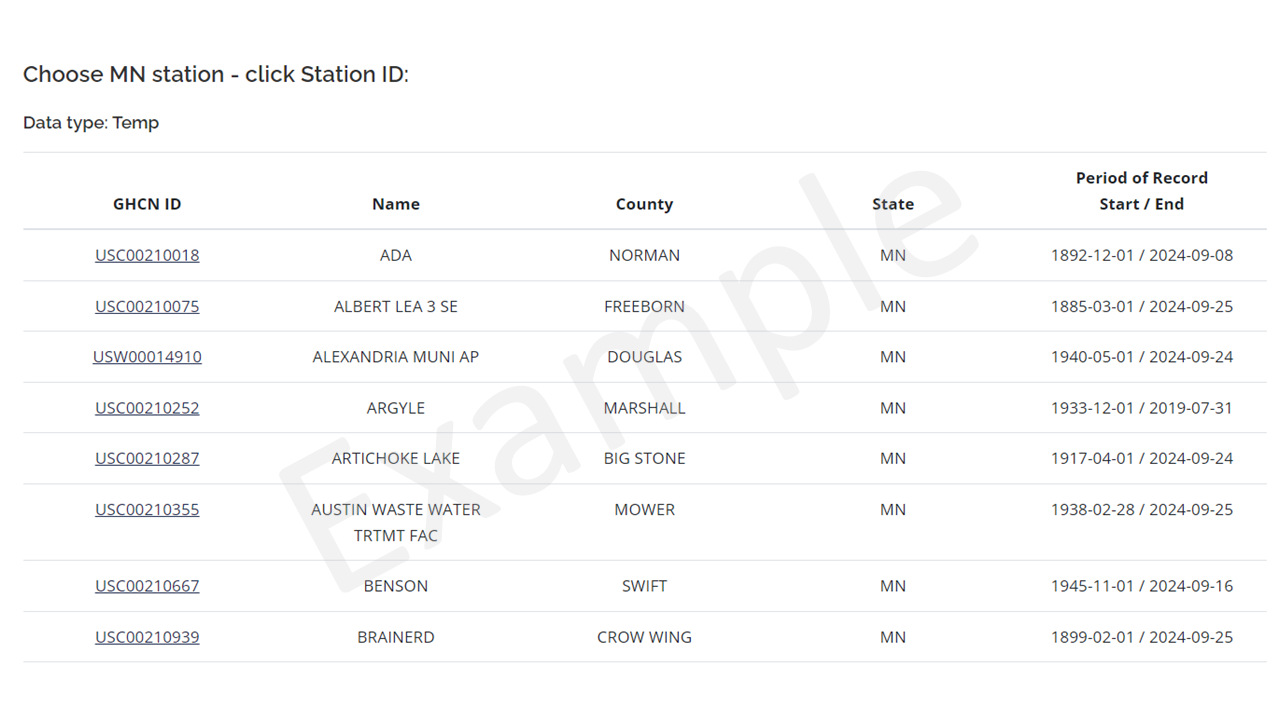
Sample Output from Climate Summary Tables by Data Type:
1991-2020 NCEI Normals for Temperature, Heating Degree Days, and Cooling Degree Days
The below table shows 1991-2020 normal values for the selected station, specifically maximum, minimum, and mean temperatures, heating degree days* (HDD, base 65°F), and cooling degree days** (CDD, base 65°F) by month and over the calendar year.
*HDD - estimate the energy needed to heat buildings. They are calculated by how many degrees the average daily temperature falls below 65°F—the more HDDs, the greater the heating required.
**CDD - estimate energy demand for cooling buildings. They measure how much the temperature exceeds 65°F—the higher the CDDs, the more cooling is needed.
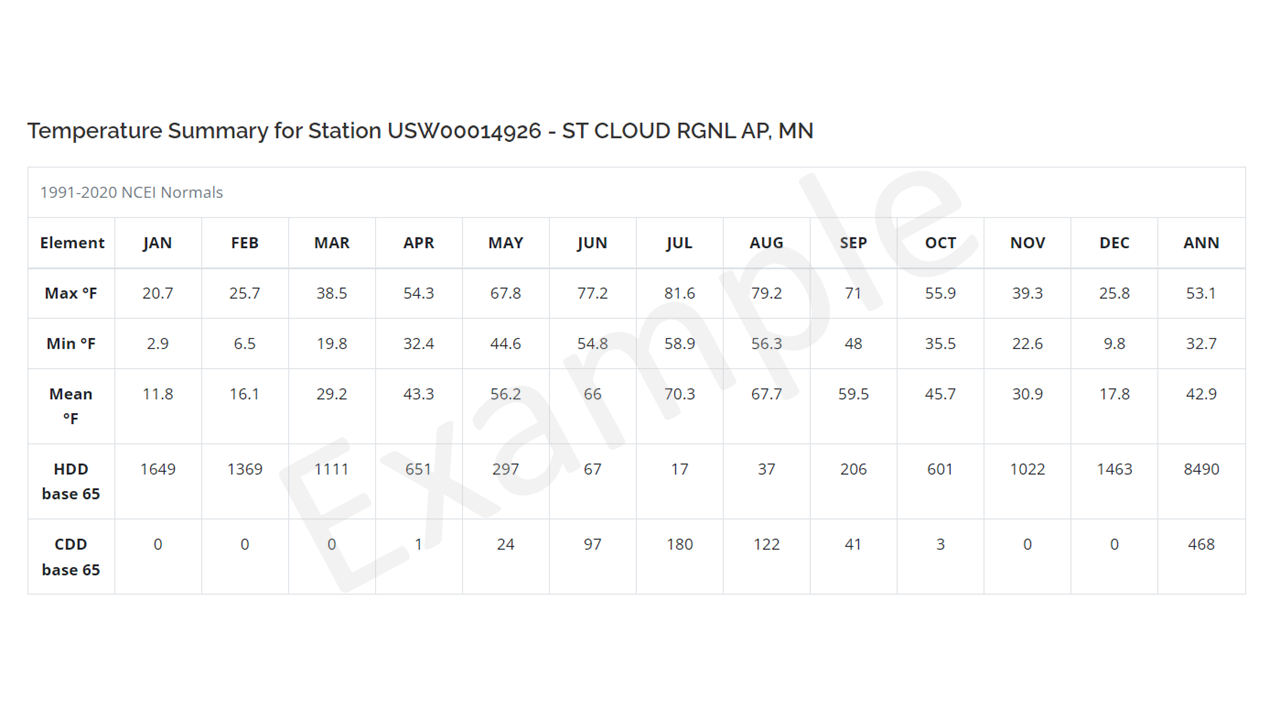
Example Interpretation:
- On average, July is the warmest month of the year, with an average temperature of 70.3°F, while January is the coldest, averaging 11.8°F.
- The highest average maximum temperature occurs in July at 81.6°F, while the lowest average maximum temperature is January with 20.7°F.
- The average annual high temperature is 53.1°F, while the average annual low is 32.7°F, resulting in an overall mean temperature of 42.9°F throughout the year.
- HDDs peak in January, which aligns with it being the coldest month. Conversely, CDDs are highest in July, reflecting that it is the warmest month.
Temperature Extremes - Period of Record: 1896-07-01 to 2024-09-24
The table below shows highest and lowest monthly, seasonal, and annual mean temperatures and the highest and lowest daily temperatures by month, season, and calendar year.
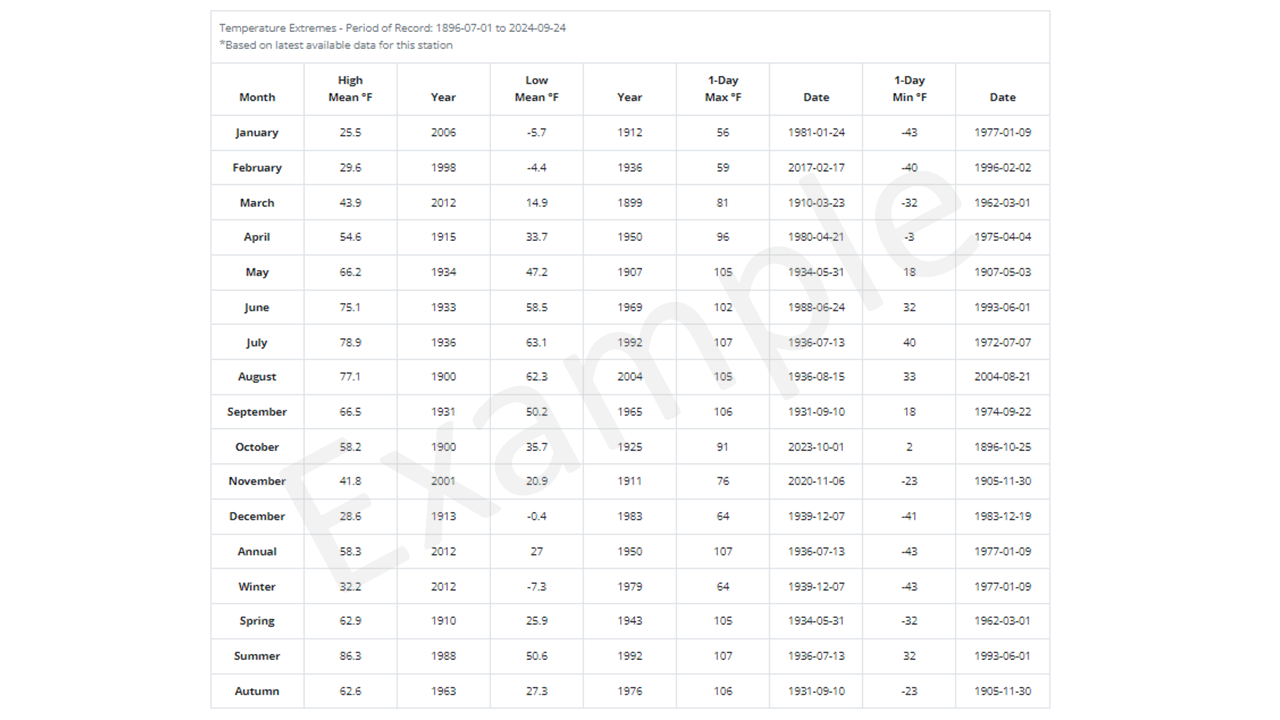
Example Interpretation:
- The highest mean temperature for January was 25.5°F, recorded in 2006.
- The lowest mean temperature during summer was 50.6°F, set in 1992.
- The all-time record for the hottest day was set on July 13, 1936, when temperatures soared to 107°F.
- On January 9, 1977, temperatures plummeted to -43°F, marking the coldest minimum temperature ever recorded at this station.
Temperature Threshold Climatology Derived from 1991-2020 Normals
The table below shows the normal numbers of days the maximum temperature is at or above 90°F, the maximum temperature is at or below 32°F, the minimum temperature is at or below 32°F, and the minimum temperature is at or below 0°F by month, season, and calendar year.
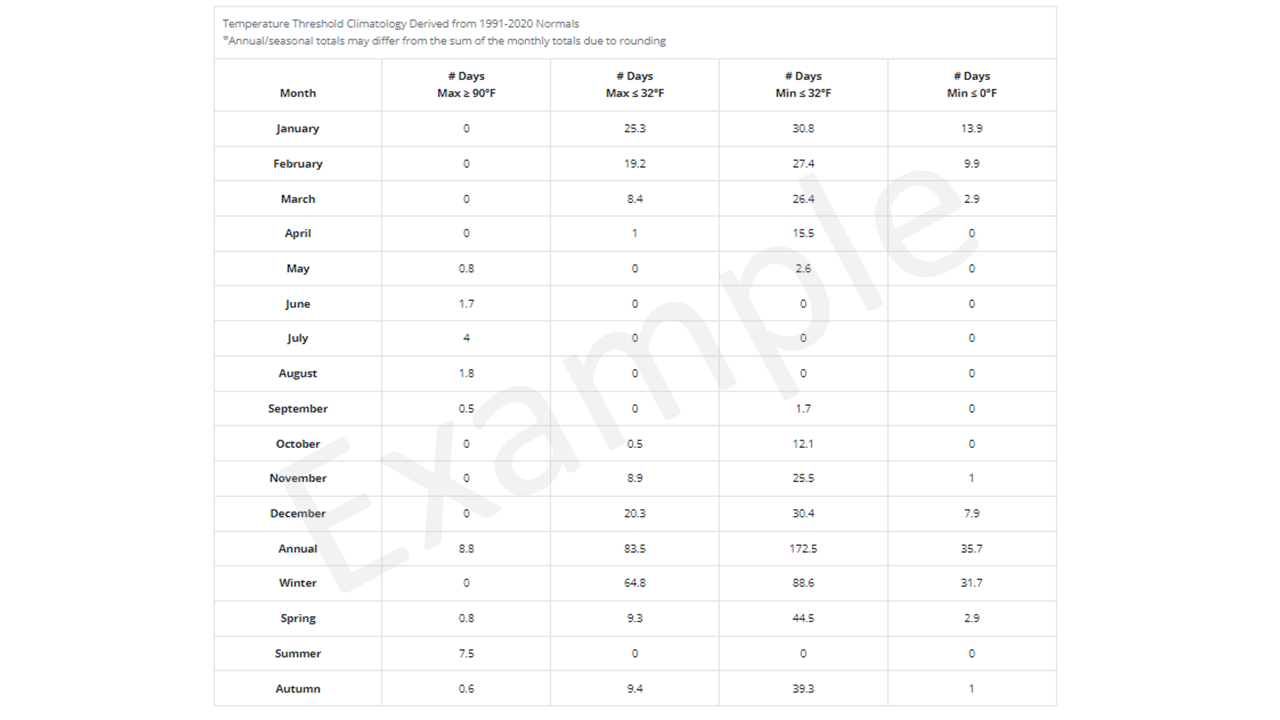
Example Interpretation:
- For this station, the average number of days in July with a maximum temperature of 90°F or higher is 4.
- Annually, the station records an average of 8.8 days with maximum temperatures at or above 90°F.
- During winter, the station averages 64.8 days with maximum temperatures at or below 32°F.
- In the autumn months, there are typically 39.3 days where temperatures fall to 32°F or lower.
- January has the highest average number of days, 13.9, with temperatures below 0°F.
1991-2020 Normals for Precipitation
The table below shows 1991-2020 normal totals for the selected station by month and over the calendar year.
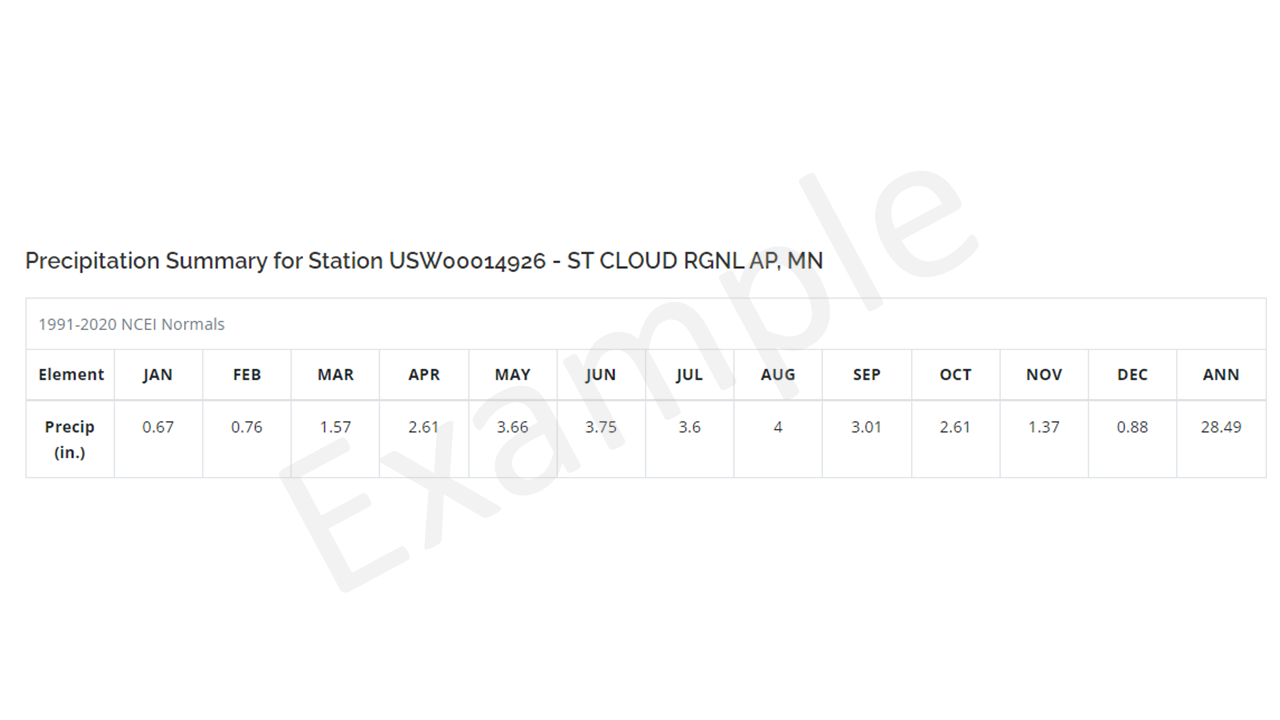
Example Interpretation:
- August is the wettest month, averaging 4 inches of precipitation, while January is the driest, with an average of 0.67 inches.
- The second driest month for this station is February with 0.76 inches.
- Annually, the station receives a total of 28.49 inches of precipitation.
Precipitation Extremes - Period of Record: 1893-03-01 to 2024-09-24
The below table shows highest and lowest monthly, seasonal, and annual precipitation totals and the highest one-day precipitation total by month, season, and calendar year.
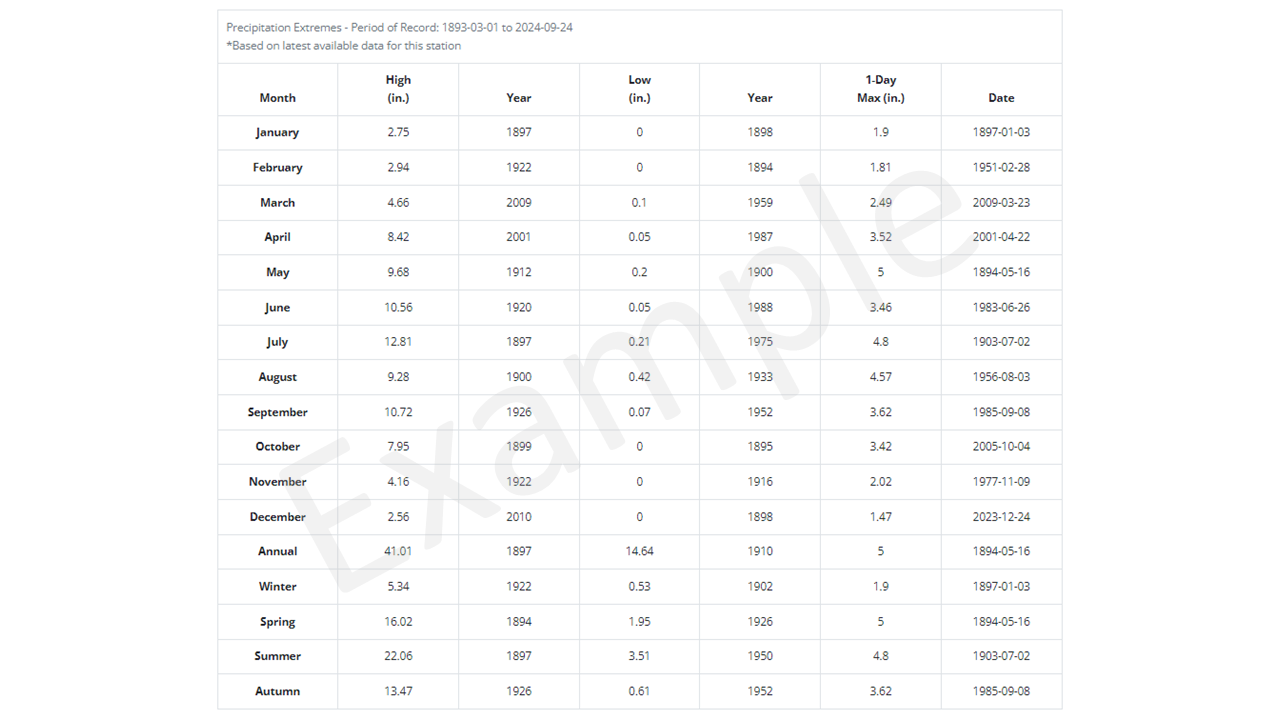
Example Interpretation:
- In July 1897, the station recorded 12.81 inches of precipitation, making it the wettest month ever documented.
- The spring of 1926 set a record for dryness, with only 1.95 inches of precipitation.
- The largest amount of precipitation to fall in a single day occurred on August 3, 1956, when 4.57 inches were recorded.
Precipitation Threshold Climatology Derived from 1991-2020 Normals
The table below shows the normal numbers of days on which precipitation totals 0.01” or more, 0.10” or more, 0.50” or more, and 1.00” or more by month, season, and calendar year.

Example Interpretation:
- Annually, the station receives 0.01 inches or more of precipitation on an average of 110.5 days. June has the highest average, with 12.3 days of at least 0.01 inches.
- During the summer months, the station typically experiences about 3 days where precipitation totals reach or exceed 1 inch.
- This table also indicates that smaller precipitation amounts are more common than larger amounts.
1991-2020 Normals for Snow
The table below shows 1991-2020 normal totals for the selected station by month and over the calendar year.
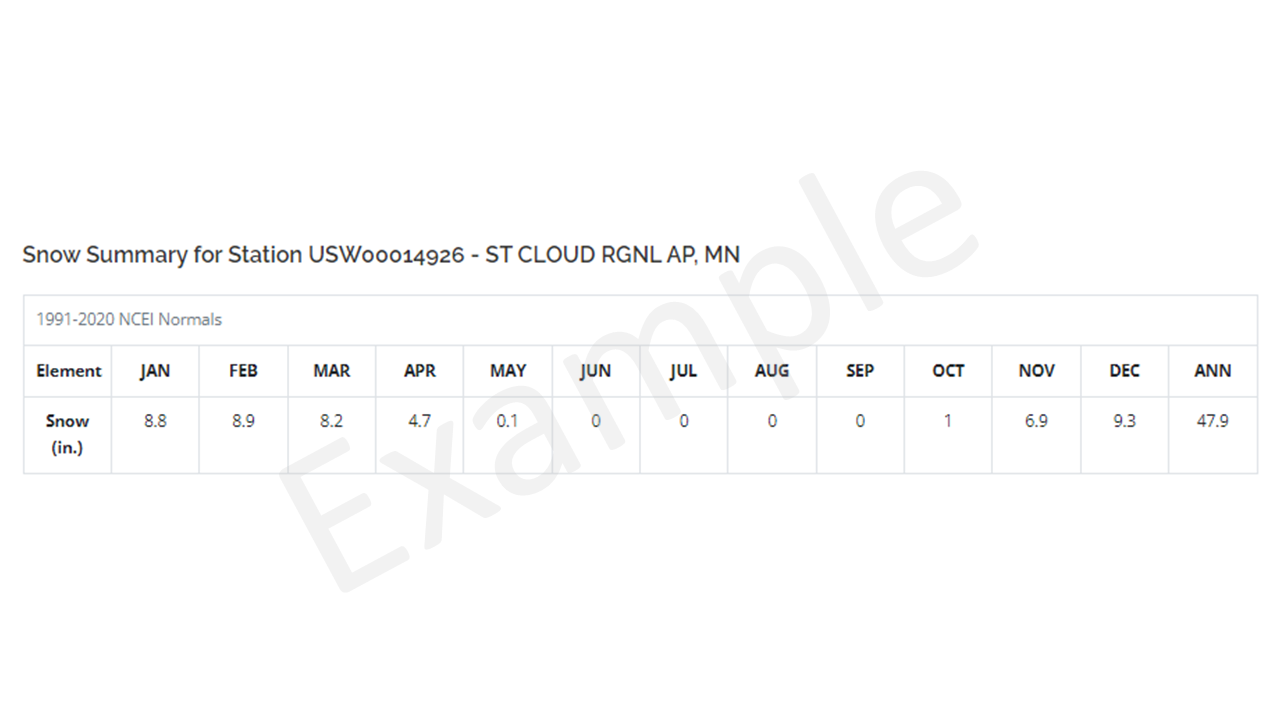
Example Interpretation:
- This station receives an average of 47.9 inches of snow annually, with the majority falling in December at 9.3 inches.
- This station measures on average 4.7 inches of snowfall in April.
- Typically, there is no snow observed between June and September.
Precipitation Extremes - Period of Record: 1904-11-10 to 2024-09-25
The table below shows highest monthly totals and highest snow season (July 1 to June 30) total as well as the highest one-, two-, and three-day snow totals by month, season, and calendar year.
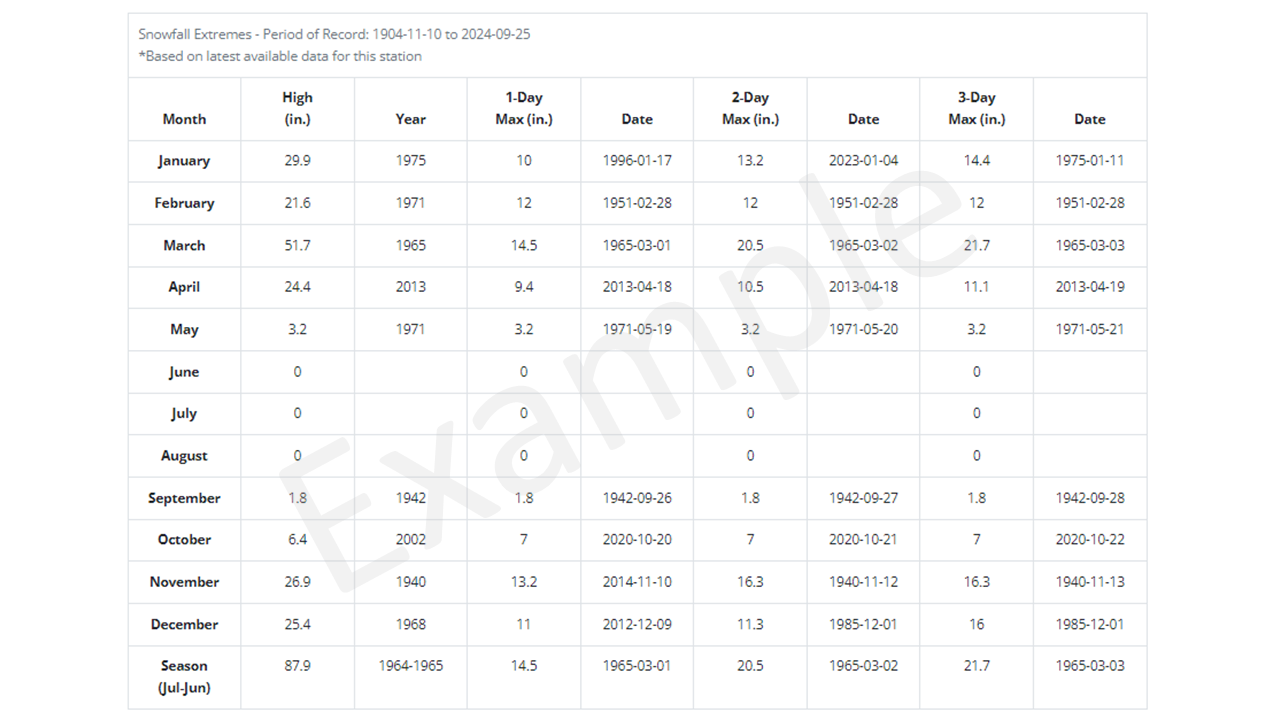
Example Interpretation:
- March 1965 was a record-breaking month for snowfall at this station, with an impressive 51.7 inches of snow measured
- The 1964-1965 snow season holds the all-time record, with a total accumulation of 87.9 inches, the most ever observed in a single snow season.
- On March 1, 1965, the station recorded its highest-ever one-day snowfall for March, measuring 14.5 inches.
- The largest 3-day snow event ever recorded in April was April 19, 2013 with 11.1 inches measured.
Precipitation Threshold Climatology Derived from 1991-2020 Normals
The table below shows the normal numbers of days on which snowfall totals 0.1” or more, 1.0” or more, 2.0” or more, and 5.0” or more by month and snow season (July 1 to June 30).
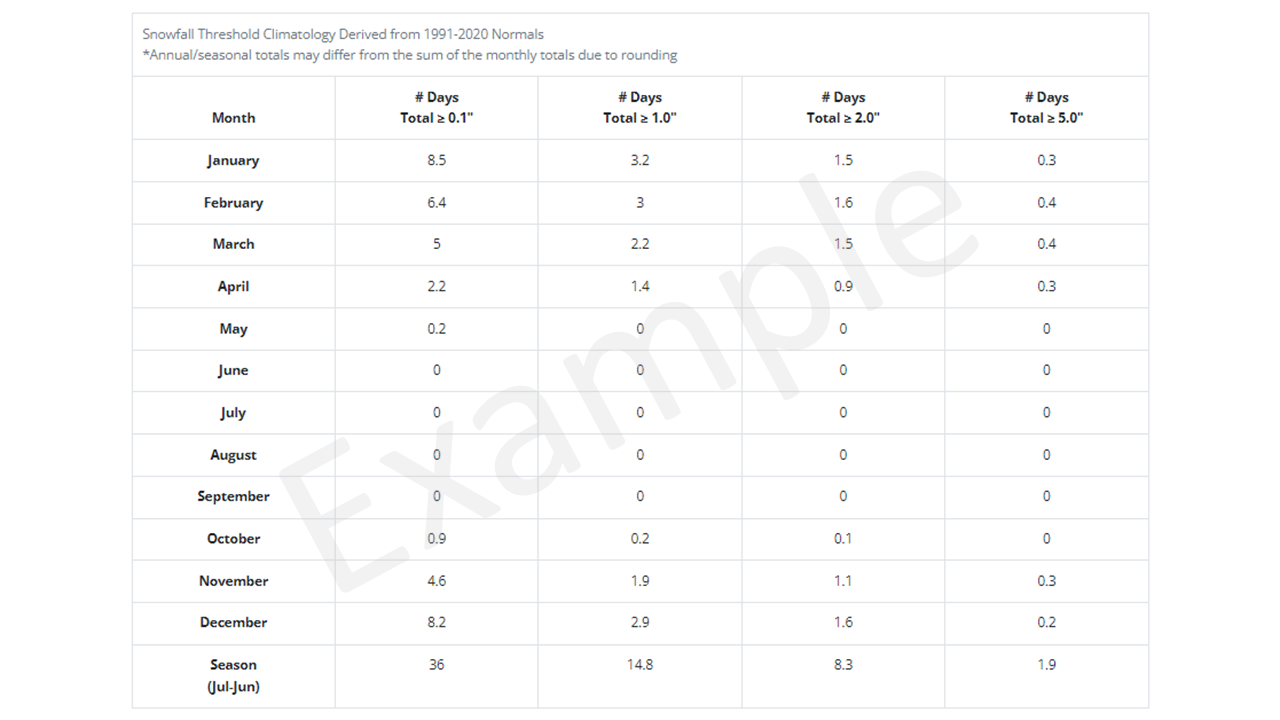
Example Interpretation:
- Each snow season, this station averages 36 days with snowfall totals of 0.1 inches or more.
- December and January have averages of 8.2 days and 8.5 days, respectively, with snowfall measuring 0.1 inches or more.
- The snow season typically includes nearly 2 days where observed snowfall totals 5.0 inches or greater.